What Is Drape In Fabric: Simple Guide To How Clothes Hang
Fabric drape is how fabric hangs and flows. It’s a key part of what makes clothes look and feel the way they do. This guide will simply explain drape. You’ll learn why it’s important for your clothes.
We’ll look at what makes some fabrics flowy, like silk. We’ll also see why others are stiffer, like denim. You’ll even learn how to see drape for yourself. Plus, we’ll touch on choosing the right labels for fabrics with different drapes.
1. What is drape? Understanding how fabric hangs
1.1 Simple definition of drape
Drape is how a fabric hangs down. Think about when you hold a piece of fabric in the air. The way it falls, makes folds, and moves by itself – that’s its drape. It’s all about how the fabric behaves because of its own weight.
Imagine a sheet of thin paper. It will probably flop down a bit – that’s like having some drape. Now think of a thick piece of cardboard. It stays stiff and holds its shape – that’s very little drape. A fabric with good drape is usually soft and bends easily. A stiff fabric doesn’t.
A soft curtain that makes gentle waves when it hangs has good drape. Your favorite comfy t-shirt probably has a nice drape too, making it feel soft. A brand new pair of stiff jeans has less drape than an old, super soft pair that has been washed many times.
1.2 Why “drape” is an important word for clothes and fabrics
Drape is a big deal for clothes because it really changes how they look on you. If a dress flows in a beautiful way, it’s thanks to the fabric’s good drape. If a jacket has a strong, sharp shape, it’s usually because the fabric has less drape and is a bit stiffer.
Drape also changes how clothes feel when you wear them. Fabrics with good drape often feel softer and more comfortable. They move easily with your body.
Knowing about drape is helpful! It helps you choose clothes that you’ll really like wearing. If you enjoy sewing or making clothes, understanding drape helps you pick the best fabric for your ideas. It’s a key thing to know to understand why some clothes just look and feel better than others.
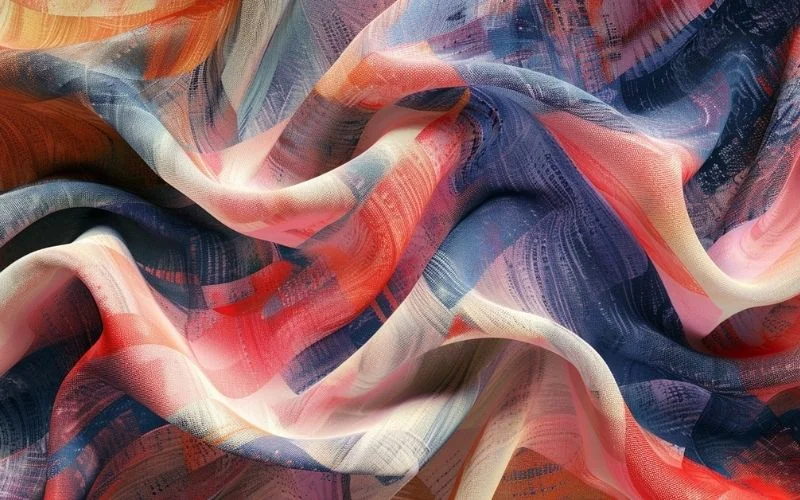
2. Why does drape matter in clothes?
2.1 How drape affects the look of your clothes
Drape really decides the overall shape, or ‘silhouette,’ of your clothes. A fabric that drapes well, like soft silk or rayon, will create soft lines and flow around your body. Think of a long, flowing skirt – that’s good drape in action! A fabric with less drape, like the sturdy cotton in a work shirt or a denim jacket, helps clothes keep a more specific, defined shape.
The drape of a fabric can make clothes look elegant, casual, or formal. Softly draping fabrics often make clothes look more elegant, graceful, or even romantic – like a beautiful evening gown. Fabrics that are a bit stiffer can make clothes look more powerful and formal (like a business suit) or give a sharp, casual look (like a crisp new jacket).
2.2 How drape affects the feel and comfort
Drape changes how fabric moves with your body. When a fabric has good drape, it moves easily. It doesn’t feel stiff or get in your way when you walk, sit, or bend. It feels natural.
Generally, fabrics that drape well feel softer and nicer against your skin. They follow your body’s shape gently instead of feeling hard or rigid. This usually means more comfort. Think about your most comfortable t-shirt. It probably has a nice, soft drape, right? It feels good to wear because it’s soft and moves easily with you.
2.3 Drape and first impressions
Often, clothes made with fabric that drapes well can look more luxurious or well-made. This is true even if the design is very simple. The way a fabric falls can give an immediate impression of higher quality.
A garment that hangs beautifully on you generally helps you look more put-together, neat, and polished. It just ‘sits’ better and looks more intentional.
From our experience at Packlove, seeing many types of garments, a good drape often elevates the entire look. It’s like a secret ingredient that makes an outfit look special. When clients bring in high-quality items for custom labels, the superior drape of the fabric is often very noticeable.
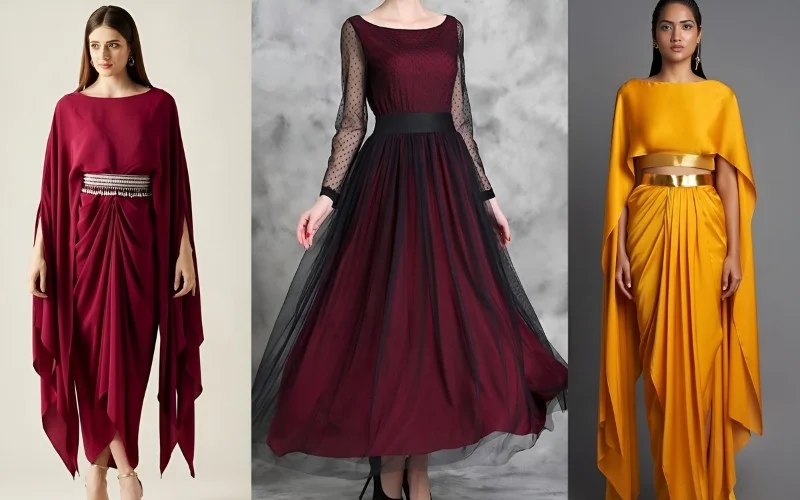
3. What makes fabric drape?
So, what actually makes one fabric flow like water and another stand stiff like a board? It’s usually a mix of these key things:
3.1 Fiber type
Fibers are the tiny, tiny threads that all fabrics are made from. Think of them as the basic ingredients of your clothes.
Natural fibers & drape:
- Silk: Silk is famous for its amazing drape! Silk fibers are very fine, smooth, and light, so silk fabric flows like liquid. It’s often used for elegant dresses and soft scarves.
- Cotton: Cotton’s drape can change a lot. Very lightweight cotton (like the kind used for summer shirts, sometimes called ‘cotton lawn’ or ‘voile’) can drape very nicely. But thicker cotton (like canvas for bags or heavy denim for jeans) is much stiffer and has less drape.
- Wool: Some types of wool, especially fine ones like ‘merino wool,’ can drape beautifully. This is why they’re used for soft sweaters or nice suit fabric. Heavier wools, like those for winter coats, are more structured and have less drape, which is good for warmth and shape.
- Linen: Linen often starts a bit crisp, meaning it has less drape when it’s new. But the great thing about linen is that as you wash and wear it, it gets much softer. It starts to drape more, giving it a relaxed, comfortable look.
Man-made fibers & drape:
- Rayon (also called Viscose): Rayon is a man-made fiber. It is often designed to feel like silk or very soft cotton. It usually has very good drape. It’s popular for flowy dresses, skirts, and blouses because it hangs so nicely.
- Polyester: Polyester can be very different! Some polyester is made to be very drapey and silky. You might find it in light blouses or linings. Other polyester fabrics are made to be stiffer and stronger, like for sportswear or bags.
- Nylon: Similar to polyester, nylon can be very drapey, like in some thin linings or lingerie. Or it can be more firm and stretchy, like in activewear or strong backpack straps.
Think about different types of hair. Very fine, soft hair falls easily and moves a lot – that’s like a fiber that helps fabric drape well. Thick, wiry hair might be stiffer and hold its shape more – that’s like a fiber that gives less drape.
3.2 Fabric weight
This is simply how heavy or light a fabric feels when you hold it. Some fabrics are very light, like a feather. Others are heavy, like a thick blanket.
Very light fabrics like chiffon (a thin, often see-through material used for scarves or layers on dresses) or organza (which is light but a bit stiffer) usually flow and move a lot if their fibers are also flexible. They can have amazing drape or be very floaty.
Heavier fabrics like thick denim (for jeans), canvas (for strong bags), or heavy wool (for winter coats) are usually stiffer. They will hang down straight because they are heavy. But they don’t always make many soft, flowing folds like lighter drapey fabrics do.
Weight itself pulls the fabric downwards. But for good drape, the fabric also needs to be flexible. It’s a combination. For example, a heavy but very flexible fabric (like some heavy silks, velvets, or certain wools) can drape beautifully, creating rich, deep folds. The weight helps it hang, and the flexibility lets it fold.
3.3 Weave or knit type
Fabric is made by putting yarns (threads) together. There are two main ways:
- Weave: This is when yarns cross over and under each other, like threads in a little basket. Many fabrics like denim, cotton shirts, and linen are woven.
- Knit: This is when yarns are looped together, like in a hand-knitted sweater or your t-shirt. Knit fabrics are often stretchy.
How tightly these yarns are packed together matters. If yarns are put together loosely, the fabric can move more easily and usually drapes better. Think of a loose-knit shawl that flows nicely. If yarns are packed very, very tightly, the fabric often becomes stiffer and has less drape. Think of tight, strong canvas used for a sturdy bag.
Specific examples:
- Satin Weave: Satin fabric (often used for shiny, smooth dresses and blouses) usually has very good drape. This is because in a satin weave, some yarns ‘float’ over several other yarns on the surface. This makes the fabric very flexible and smooth, so it hangs beautifully.
- Jersey Knit: Jersey fabric (common for t-shirts, leggings, and comfy dresses) typically drapes well. Its looped structure allows it to stretch and fall softly against the body, creating a relaxed drape.
- Plain Weave (e.g., basic cotton shirting, quilting cotton): The drape of plain weave fabric can vary. If it’s woven tightly with thicker yarns, it will be crisper with less drape. If it’s woven more loosely with finer yarns, it will drape more.
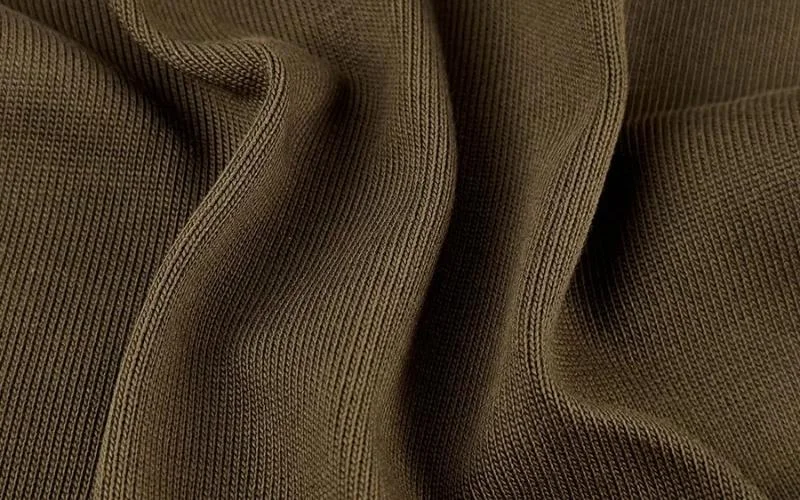
3.4 Yarn type and thickness
Yarns are the actual strands of thread that are used to weave or knit fabrics. These yarns are made from the fibers we talked about earlier, like cotton fibers twisted into cotton yarn.
This makes a difference! Fabrics made from very thick, bulky yarns (like the yarn used for a really chunky winter sweater) will likely be heavier and stiffer, with less drape. Fabrics made from very fine, thin yarns (like those used for a delicate silk scarf or a sheer blouse) can be much lighter and more flowy, leading to better drape.
The texture of the yarn matters too. Smooth, slippery yarns (like silk yarns or some smooth polyester yarns) help the fabric glide and drape well. The yarns can slide past each other easily. This allows the fabric to fold softly.
Rough or highly textured yarns (like some tweeds, or ‘slub’ cottons that have little lumpy bits in the yarn) might create a fabric that doesn’t flow as easily. The textured yarns can catch on each other a bit or create more structure, reducing the soft drape.
Imagine making a necklace. A necklace made from a fine, smooth chain will hang down and curve easily around your neck – that’s like good drape. A necklace made from chunky, rough beads will be much stiffer. It won’t follow curves as well – that’s like less drape. Yarns in a fabric work in a similar way.
3.5 Fabric finishes
Sometimes, after a fabric is made, it gets special treatments called ‘finishes.’ These are like adding a final touch. They can change how the fabric feels, looks, and also how it drapes.
- Some finishes make fabrics feel much softer, which can help them drape better.
- Other finishes are designed to make fabrics stiffer. Think of the special finish on a new, crisp shirt collar, or some treatments that make fabric water-resistant. These finishes reduce the fabric’s drape.
- Think about some brand new jeans – they often feel very stiff. This can be due to a finish. After you wash them a few times, this finish might wear off. The jeans become softer and drape more.
4. Examples of fabrics and their drape
4.1 Fabrics with good/excellent drape
These fabrics feel soft to the touch. They move easily, almost like liquid! They create lovely, gentle folds when they hang. They are often lightweight but can also be heavier if they are very flexible.
- Silk: Silk is the star when it comes to drape! Its fibers are naturally very fine, smooth, and light. This allows silk fabric to flow beautifully and feel luxurious against the skin. Think of elegant dresses that swish when you walk, soft blouses, and flowing scarves.
- Chiffon: Chiffon is very lightweight and often a bit see-through. It has an amazing, airy drape, almost like it floats on air. It’s often used for layers on special occasion dresses, fancy scarves, or bridal veils.
- Rayon (also known as Viscose): Rayon is a man-made fiber but it often feels like soft cotton or even silk. It drapes much better than most cottons, hanging in soft folds similar to silk. It’s a great choice for flowy summer dresses, skirts, and tops that need to move gracefully.
- Jersey Knit (especially lighter weights): This is the fabric often used for your comfy t-shirts, stretchy dresses, and loungewear. Because it’s knitted (made with loops), it’s usually stretchy and falls nicely against the body, giving it a soft, relaxed drape.
- Charmeuse (often made from silk or polyester): Charmeuse is a type of satin-weave fabric. It is very lightweight and has a beautiful sheen on one side and a duller back. It has excellent, fluid drape. This makes it popular for lingerie, slinky blouses, and flowing evening gowns.
You’ll often see these fabrics used for any clothing where you want a lot of movement and softness. This includes flowy dresses, soft skirts, elegant blouses, light scarves, and comfortable tops.
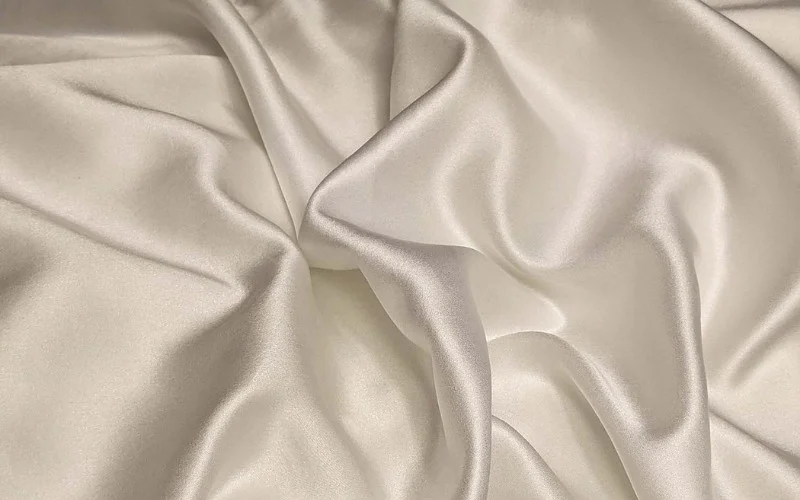
4.2 Fabrics with moderate/average drape
These fabrics have some softness and can make nice folds. But they also have a bit more ‘body’ or structure than the super-flowy ones. They are not extremely fluid, but not super stiff either. They offer a balance.
- Lightweight Cotton (e.g., cotton lawn, poplin, chambray): These types of cotton are often used for summer shirts, casual dresses, and children’s clothes. Cotton lawn is very fine and drapes well for cotton. Poplin is a bit crisper but still has some give. Chambray (often looks like lightweight denim) is also soft with moderate drape. They are soft enough to drape, but can also hold a little shape, like for a slightly crisp collar or a neat pleat.
- Linen: As we mentioned, when linen is new, it can be a bit crisp with less drape. But as it’s washed and worn, it softens considerably. It develops a lovely, relaxed drape that many people love for its casual, comfortable elegance. It’s great for summer shirts, pants, and dresses.
- Lightweight Wool (e.g., tropical wool, wool challis): Not all wool is heavy like coat wool! Some lighter wool fabrics are designed for suits, trousers, or skirts that can be worn in warmer weather. These can drape quite nicely. They offer some structure but also allow for movement and comfort.
4.3 Fabrics with poor/stiff drape
These fabrics don’t flow much, if at all. They tend to hold their own shape. They can feel firm, crisp, or even rigid. This isn’t always a bad thing – sometimes this stiffness is exactly what you need for a specific look or purpose!
- Heavy Denim: Think of brand new, unwashed jeans, especially ‘raw denim.’ Heavy denim is quite stiff. It doesn’t make soft, flowing folds but creates a strong, structured look. It does soften with a lot of wear and washing, gaining a little more drape over time.
- Canvas: Canvas is a very strong, plain-woven fabric, usually made from cotton or linen. It’s used for things that need to be tough and hold their shape. Examples include tote bags, tents, heavy-duty work clothes, and artists’ painting canvases. It has very little drape because its job is to be durable and structured.
- Felt (non-woven type): Felt is usually thick. It is made by pressing and matting fibers together, not by weaving or knitting them. This makes it quite stiff and it doesn’t flow or drape. It’s good for crafts, some types of hats, or structured decorative items.
- Corduroy (especially wide-wale or heavyweight): The raised ridges (called ‘wales’) in corduroy give it texture and structure. Heavier types of corduroy can be quite stiff. They are often used for durable trousers, jackets, and even upholstery.
- Brocade or Heavy Tapestry Fabrics: These are often decorative fabrics with complex, sometimes raised, woven patterns. They are usually quite stiff due to their construction and the types of yarns used. They’re used for formalwear like structured jackets, ornate vests, upholstery, or fancy bags where a rich, structured look is desired.
These stiffer fabrics are used for structured jackets that need to keep their shape. They are also used for sturdy bags, some types of hats, and upholstery that needs to be durable. They suit any item where you need the fabric to stand up on its own or resist bending easily.
4.4 How drape is described
People use many different words to talk about how a fabric drapes. Knowing some of these words can help you understand descriptions when you’re shopping for fabric or clothes. It can also help you explain what you’re looking for.
- Fluid: Moves very easily, like liquid; very flowy.
- Flowy: Hangs in graceful, moving folds.
- Soft: Falls gently, feels pleasant and pliable.
- Supple: Flexible, bends and moves easily without being limp.
- Clingy: Tends to hang very close to the body.
- Crisp: A bit stiff, makes sharper, cleaner folds.
- Stiff: Holds its own shape well, doesn’t flow or bend easily.
- Rigid: Very stiff, almost no movement or bending.
- Bouncy: Has some weight but also some springiness.
- Limp: Lacks body, hangs down without much life.
5. How to see or test fabric drape yourself
5.1 The simple hanging test
- Find a piece of the fabric you want to test. If you’re in a fabric store, ask if you can unroll a good length from the bolt (the big roll of fabric). You’ll want at least an arm’s length, or about a yard/meter if possible, to see it well.
- Hold the fabric up by one edge or a corner. Let the rest of it hang down freely.
Now, look closely at how it falls.
- Does it make many soft, rounded folds?
- Or are the folds fewer, sharper, and stiffer?
- Does the fabric fall straight down, close to your hand? Or does it stick out a bit, trying to hold its own shape away from your hand?
Generally, if you see lots of soft, rounded, plentiful folds, that usually means the fabric has good drape. If there are fewer folds, and they look sharper or stiffer, or if the fabric holds its shape more, then it has less drape. If it seems to almost float and moves with the slightest breeze, it’s very light with good drape.
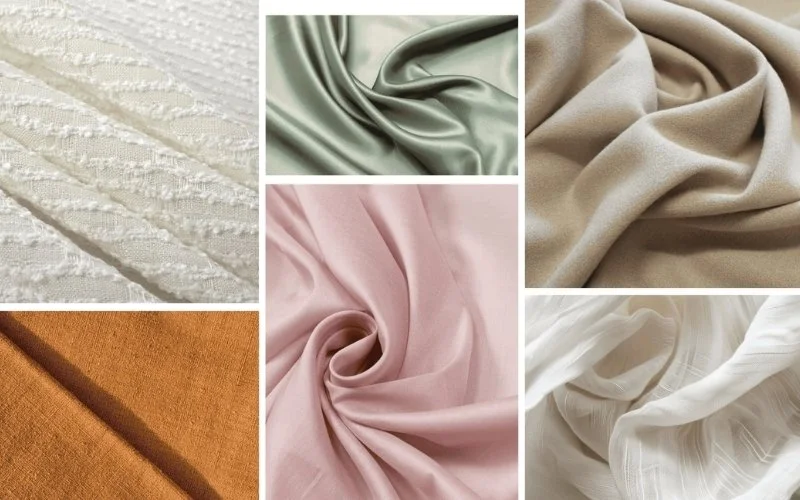
5.2 The hand test
Another quick test is to use your hands. Gently take a section of the fabric and try to scrunch or crush it in your hand. How does it feel?
Pay attention to these things:
- Does it feel soft, pliable (easy to bend), and easy to crush in your hand? This often means it will drape well.
- Or does it feel firm, perhaps a bit springy, and resist being crushed? This usually suggests a stiffer drape.
- When you let the fabric go from your scrunched hand, does it fall softly and smoothly? Or does it stay a bit crumpled, or spring back quickly to its original stiff shape?
5.3 Observing clothes in stores or your closet
The best way to get good at understanding drape is to start paying attention to clothes all around you! When you’re shopping or looking through your own closet, really look at how different garments hang. Compare a flowy summer dress to a structured denim jacket. Notice how a silk blouse moves differently than a crisp cotton work shirt.
This is a fantastic way to train your eye. Soon, you’ll start to automatically connect the look and feel of different fabrics to how well they drape. If you’re in a store and it’s okay to do so, touch the fabrics. Try the ‘hanging test’ or the ‘hand test’ and see how your results match the finished clothes.
6. Drape in fashion design and sewing
6.1 Choosing fabric for a project
If you enjoy sewing your own clothes or designing them, picking a fabric with the right kind of drape is super important. It can make the difference between your project turning out just how you imagined it, or looking a bit off.
Think about what you want to make:
- Want to sew a flowy, romantic sundress or a soft, swishy skirt? You’ll need a fabric with good drape. Examples include rayon, a lightweight cotton voile, chiffon, or even silk.
- Planning to make a tailored jacket that needs to hold its shape and look sharp? You should choose a firmer fabric with less drape. Think medium-weight wool, sturdy cotton twill, denim, or corduroy.
Most sewing patterns will give you suggestions for what types of fabric to use. Pay attention to these! The pattern designer chose those suggestions because they know what kind of drape is needed for the garment to hang correctly.
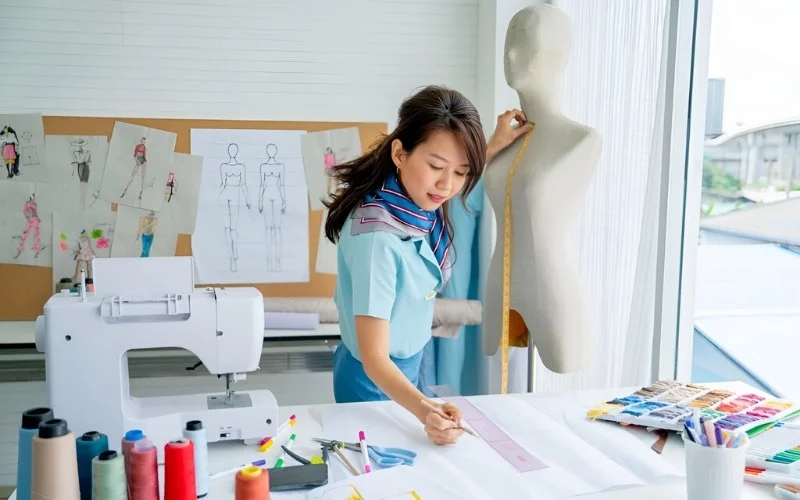
6.2 Using drape for effect
Here’s a special trick that fashion designers often use: cutting the fabric ‘on the bias.’ Normally, fabric is cut along its straight threads. Cutting on the bias means cutting it diagonally (at a 45-degree angle to the fabric’s edge). This makes many woven fabrics hang, stretch, and cling to the body in a more fluid way. It’s often used for elegant evening gowns.
Fashion designers think a LOT about drape! It’s one of their main tools. They choose specific fabrics for how their drape will help create the look they want. The drape of the fabric helps bring their design sketches to life.
7. Understanding drape made easy
Let’s quickly remember the main things about fabric drape:
- Drape is simply how a fabric hangs, falls, and flows naturally because of its own weight.
- What the fabric is made of (the fiber), how heavy it is (fabric weight), and how the threads are put together (the weave or knit type) are the biggest things that change drape.
- Good drape usually means the fabric is soft, moves well, and can make clothes look and feel more elegant or comfortable.
- Fabrics with less drape are stiffer and hold their shape more. This is good for structured clothes.
- Knowing about drape helps you choose clothes you’ll love and pick the right fabrics if you like to sew.
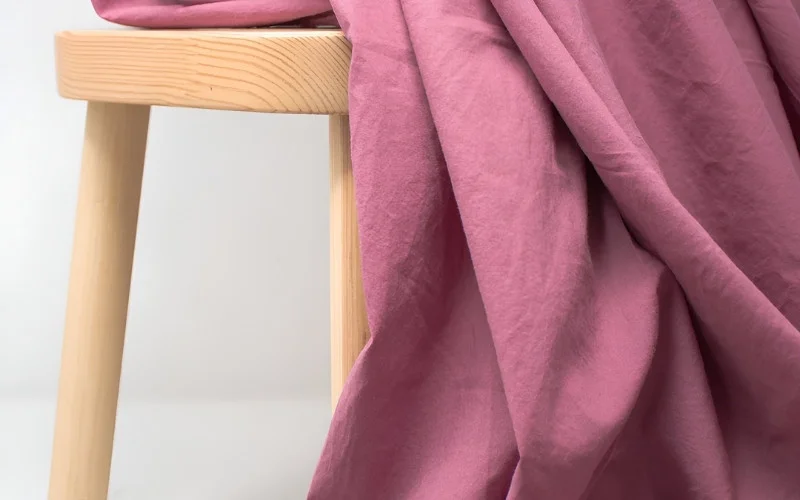
Now that you’re becoming an expert on fabric drape, let’s think about labels and tags. The drape of your fabric can even influence the best type of label to choose! Imagine a beautiful, super soft, and flowy silk blouse. A stiff, thick, or scratchy label could feel uncomfortable or spoil how the fabric hangs. The label should work with the fabric, not against it.
For lightweight, delicate, or very drapey fabrics, softer and more flexible label options are best. At Packlove, we often recommend:
- Soft Woven Labels: Our ‘damask’ woven labels are an excellent choice. Made by weaving threads together very finely, they are exceptionally soft and flexible, moving gracefully with the fabric.
- Printed Satin Labels: These labels are smooth, often have a slight sheen, and are very flexible. They lie flat and won’t add stiffness.
- Heat Transfer Labels (Tagless Tags): These are a fantastic option because they are printed directly onto the fabric using heat and pressure. With no extra material, they offer ultimate comfort and are perfect for delicate fabrics.
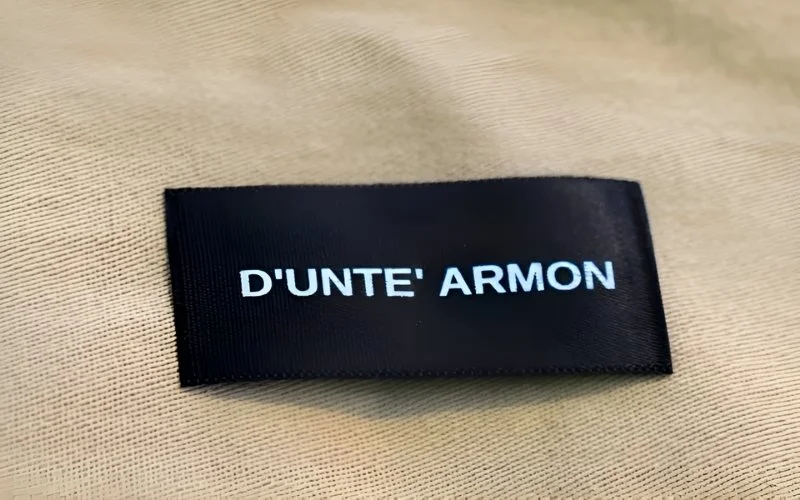
9. Frequently asked questions about fabric drape
9.1 What is the difference between drape and weight?
Fabric weight is just about how heavy or light a fabric is. Fabric drape is how that fabric hangs, folds, and moves because of its weight AND other things like fiber and weave.
So, a fabric can be heavy but still drape beautifully if it’s also very flexible. Or, a fabric can be lightweight but still be quite stiff. Weight influences drape, but they are not the same.
9.2 Can a heavy fabric have good drape?
Yes, definitely! Think of a luxurious heavy velvet curtain or a beautiful heavy silk gown. These fabrics have weight, but their fibers or construction allow them to be very flexible. The weight actually helps them hang beautifully and create dramatic folds. It’s about being flexible for its weight.
9.3 Does drape change after washing?
Sometimes, yes.
- Some fabrics, like linen or certain cottons, can get softer and drape better after washing.
- Other fabrics might get stiffer or lose drape if not washed carefully (always check the care label!).
- Good quality fabrics, cared for properly, usually keep their drape well.
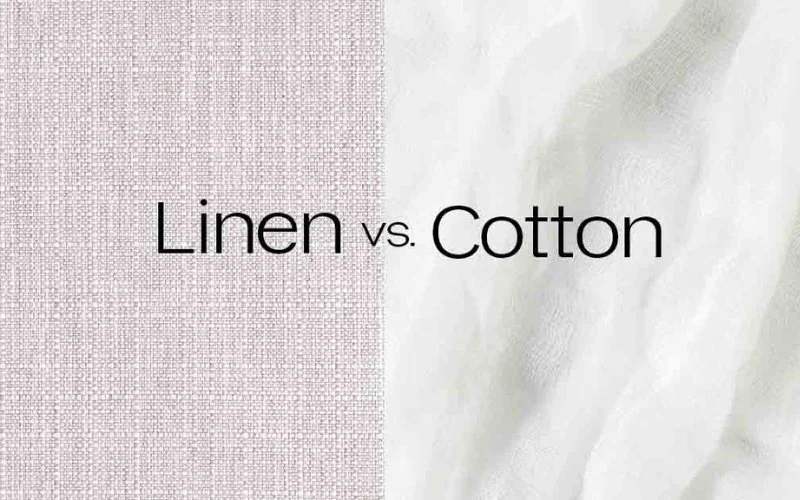
9.4 Which fabric has the best drape for a flowy dress?
For a dress that flows beautifully, look for fabrics with excellent drape. Some of the best choices include:
- Silk (especially silk charmeuse, silk crepe de chine, or silk chiffon)
- Chiffon (very lightweight, often sheer, floats wonderfully)
- Rayon (also known as viscose – great alternative to silk for drape)
- Soft Jersey Knit (especially those with fine, soft yarns)
- Georgette (similar to chiffon but usually a bit heavier, still great flow)
Explore more:
Understanding fabric drape doesn’t have to be complicated—it’s simply about how fabric falls and moves. Whether you’re choosing material for a sewing project or just shopping for clothes that look and feel right, knowing about drape can help you make better, more confident decisions.
From soft, flowy fabrics to structured, stiff ones, drape plays a big role in both style and comfort. Now that you know what affects drape and how to test it, you’re one step closer to picking the perfect fabric for any occasion.






















